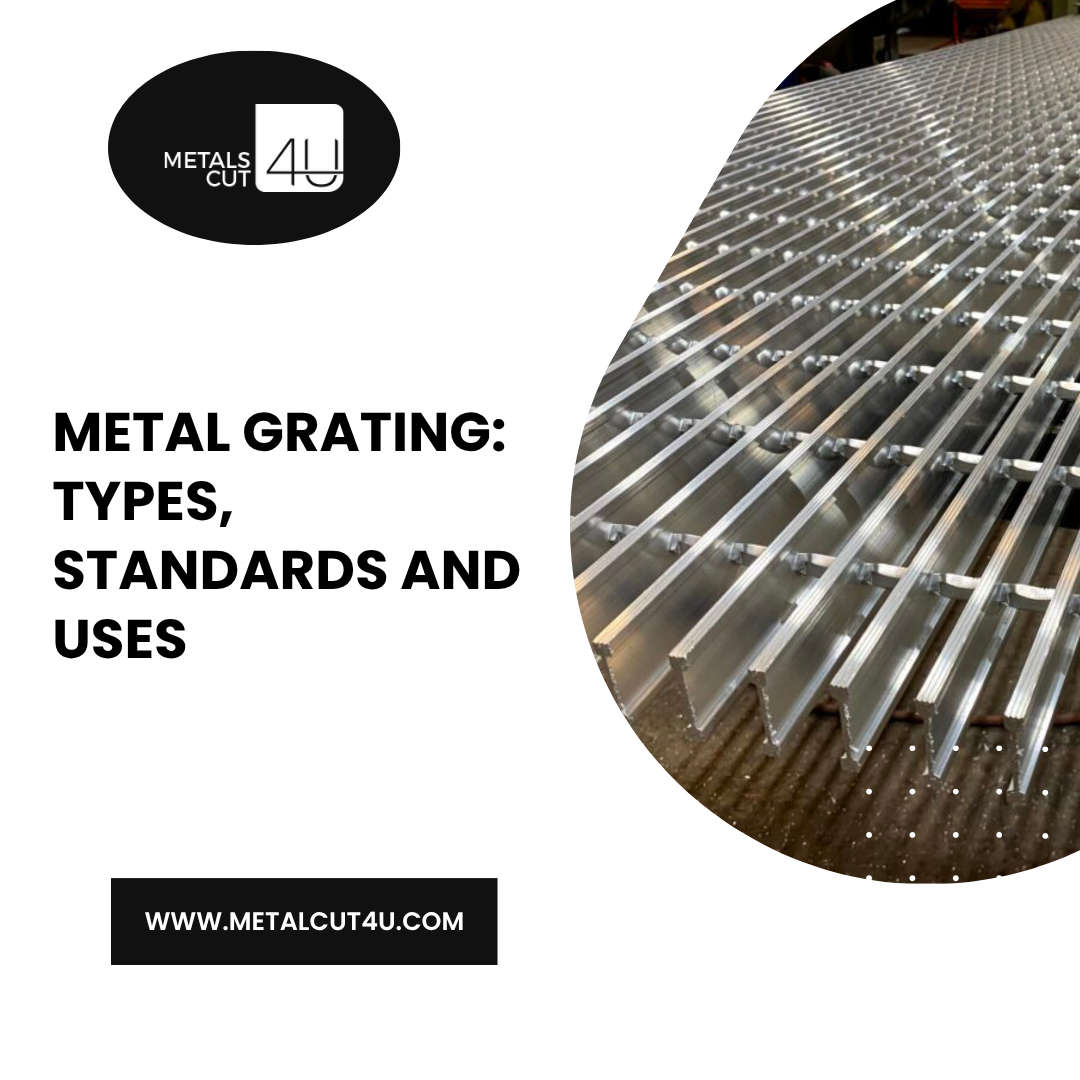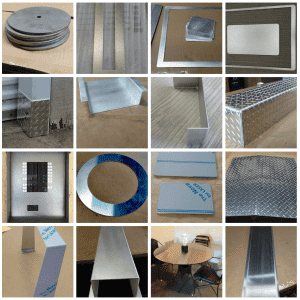Metal Grating: Types, Standards and Uses

Metal grating is a key material used in various industries for its durability, strength, and versatility. It is used in applications where safety, strength, and stability are essential. Whether you're building industrial platforms or walkways, understanding the types of metal grating and their uses can help you make the right decision for your projects.
In this blog, we will explore the basics of metal grating, its types, benefits, and metal grating applications, to equip you with the knowledge for informed project decisions.
What Is Metal Grating?
Metal grating refers to a structure made from parallel metal bars or wires that are arranged in a regular pattern. These grids are typically fabricated from materials such as steel, aluminum, or stainless steel and are widely used in construction, industrial, and commercial applications. They are designed to allow the passage of light, air, water, and debris, while providing a stable surface for walking or industrial use.
The primary function of metal grating is to provide safe, durable, and easy-to-maintain surfaces, often in environments where heavy loads are present. The metal grating structure is ideal for applications requiring both strength and resistance to wear, corrosion, and impact. Its production often involves various sheet metal fabrication techniques to ensure precision, consistency, and durability across different applications.
Understanding the Basics of Metal Grating
Metal grating can be categorized into several types depending on the manufacturing process and intended use. The most common types include expanded metal, perforated metal, bar grating, wire mesh, and safety grating. These different types of metal grating offer varying levels of strength, accessibility, and safety, serving specific purposes.
Choosing the right type of metal grating depends on several factors, including the load-bearing requirements, safety features, and environmental conditions the grating will be exposed to.
Types of Metal Grating
Understanding the types of metal grating is essential when selecting the right material for your project. Each type has distinct characteristics and is suited to different applications. Below are the most popular types of metal grating.
-
Expanded Metal Grating
Expanded metal grating is produced by taking a flat sheet of metal and then stretching or expanding it to create a diamond-shaped pattern. This process ensures that the metal retains its strength and rigidity while providing an open mesh structure. It is commonly used in applications where a high level of visibility and ventilation is required.
-
Perforated Metal
Perforated metal grating is made by punching holes into a sheet of metal in a pattern. This type of grating is frequently used in industries where filtration, drainage, or lightweight construction is necessary. The hole patterns in perforated metal grating can vary in size and shape, depending on the specific project requirements.
-
Bar Grating
Bar grating is one of the most commonly used types of metal grating. It is made by welding or forging metal bars together to form a grid pattern. However, other methods also exist to join the bars together. The bars can be arranged in either a parallel or a perpendicular configuration, depending on the intended application. There are several bar grating types, including light-duty, heavy-duty, and custom options.
-
Wire Mesh
Wire mesh grating consists of metal wires arranged in a grid pattern and typically welded at the intersections. This type of grating is ideal for applications that need a flexible and lightweight solution. Wire mesh is often used in fencing, screening, and industrial purposes where the strength-to-weight ratio is essential.
-
Safety Grating
Safety grating is designed to prevent slip hazards, offering superior traction underfoot. It is often used in walkways, stair treads, and other high-traffic areas where safety is a top priority. This type of grating features a serrated surface to provide added grip, even in wet or slippery conditions.
Many of these metal grating types are designed for installation within larger structural assemblies, where precise and durable metal frame fabrication is crucial to ensure proper support, alignment, and long-term performance.
What is Metal Grating Used For?
Metal grating is an incredibly versatile and durable material, widely used across various industries. Its design makes it ideal for various applications. Whether it's heavy-duty metal grating designed to withstand significant loads in industrial settings or lighter versions for public walkways, this material consistently provides reliable and long-lasting solutions. Below are some of the most common metal grating uses:
-
Industrial platforms
-
Walkways
-
Fire escape platforms
-
Safety fences
-
Grilles
-
Trailer beds
Advantages of Metal Grating
Several benefits of metal grating make it a popular choice in many projects. Some of the key advantages include:
-
Durability: Metal grating is resistant to wear and tear, making it suitable for use in harsh environments.
-
Load-bearing capacity: Different types of grating are available to accommodate various load requirements, ensuring safety and stability.
-
Corrosion resistance: Metal grating, particularly steel metal grating, is often coated with anti-corrosive materials like galvanization or powder coating to increase its lifespan.
-
Low maintenance: Metal grating is easy to clean and requires minimal upkeep, making it ideal for high-traffic areas.
Choosing the Right Metal Grating
When selecting the right metal grating for a specific application, there are several factors to consider:
-
Material:
The material of the grating will impact its strength, durability, and resistance to corrosion. Steel metal grating is one of the most popular choices due to its strength and versatility. Stainless steel or aluminum may also be used in environments with high corrosion potential, depending on the metal grating specifications required for the project.
-
Load Requirements:
The load capacity of metal grating is crucial, particularly in heavy-duty metal grating applications. Heavy-duty metal grating can support higher loads than lighter-duty alternatives, making it ideal for use in industrial and transportation settings. These factors play a major role in determining the suitable types of sheet metal for the job.
-
Safety Features
If the metal grating is intended for pedestrian use, safety features such as serrated surfaces or anti-slip coatings may be necessary to prevent accidents. Understanding the uses of metal grating in various environments can help determine the right safety features to incorporate.
-
Fabrication Capabilities
Custom metal grating options are available for projects requiring specialized dimensions or designs. Custom sheet metal fabrication services make it possible to create grating that meets unique requirements in terms of size, shape, and functionality, ensuring optimal performance and fit for your specific application.
-
Compatibility
Final Words on Metal Grating: Types, Standards, and Its Uses
In conclusion, metal grating plays a crucial role in various industrial, commercial, and construction applications. Whether it’s steel metal grating, heavy-duty metal grating, or bar grating types, the material, load-bearing capacity, and safety features must all be considered when selecting the right grating for your needs. Understanding the types of metal grating and their specifications ensures you choose the best option for your project.
Contact MetalsCut4U today to discuss your next project and benefit from our expertise in metal grating and sheet metal manufacturing process. We'll help you find the perfect solution for your needs.
Metal Grating FAQs
1. Is grating the same as shredding?
No, grating refers to the open-mesh, grid-like panel or structure made from metal, typically used for surfaces, covers, or screens where strength, airflow, and drainage are needed. Shredding, by contrast, involves tearing materials into smaller, often irregular, pieces, typically for disposal or recycling purposes.
2. What is metal grinding dust called?
Metal grinding dust is commonly known as "metal fines" or "grinding swarf." These are the tiny particles produced when metal is machined or ground.
3. What is the difference between grating and testing?
Grating, in the context of metal, creates an open grid. Zesting is a culinary term for removing the outer peel of citrus fruits using a fine grater, primarily for flavor.
4. Why are metal grates installed?
Metal grates are installed for essential purposes like providing safety, structural support, ventilation, and drainage. They are crucial in industrial and commercial settings for robust surfaces.
5. Where is metal grating commonly used?
Metal grating is widely used in industrial platforms, walkways, stair treads, safety fences, and drainage covers. Its strength and durability make it ideal for demanding environments.
6. Can metal grating be custom-fabricated?
Yes, metal grating can absolutely be custom-fabricated to meet the precise and unique demands of specific projects. This allows for tailored solutions regarding dimensions, load-bearing capacities, material types, and even surface finishes, ensuring a perfect fit for any application.
7. What is the load capacity of metal grating?
The load capacity of metal grating varies significantly based on its type and material. Heavy-duty metal grating is designed to support much higher loads than standard options.
8. How do you maintain metal grating?
Maintaining metal grating requires regular cleaning and inspection. This prevents debris buildup and helps identify any wear or damage, ensuring its safety and integrity.
9. What is the price range of metal grating?
The price varies depending on the type of metal, material, and custom specifications. Steel metal gratin is typically more affordable than stainless steel. For more information about the costs, please contact us.
10. Is metal grating recyclable?
Yes, metal grating made from materials like steel or aluminum is highly recyclable. This allows it to be reused in other applications, supporting sustainable practices.
